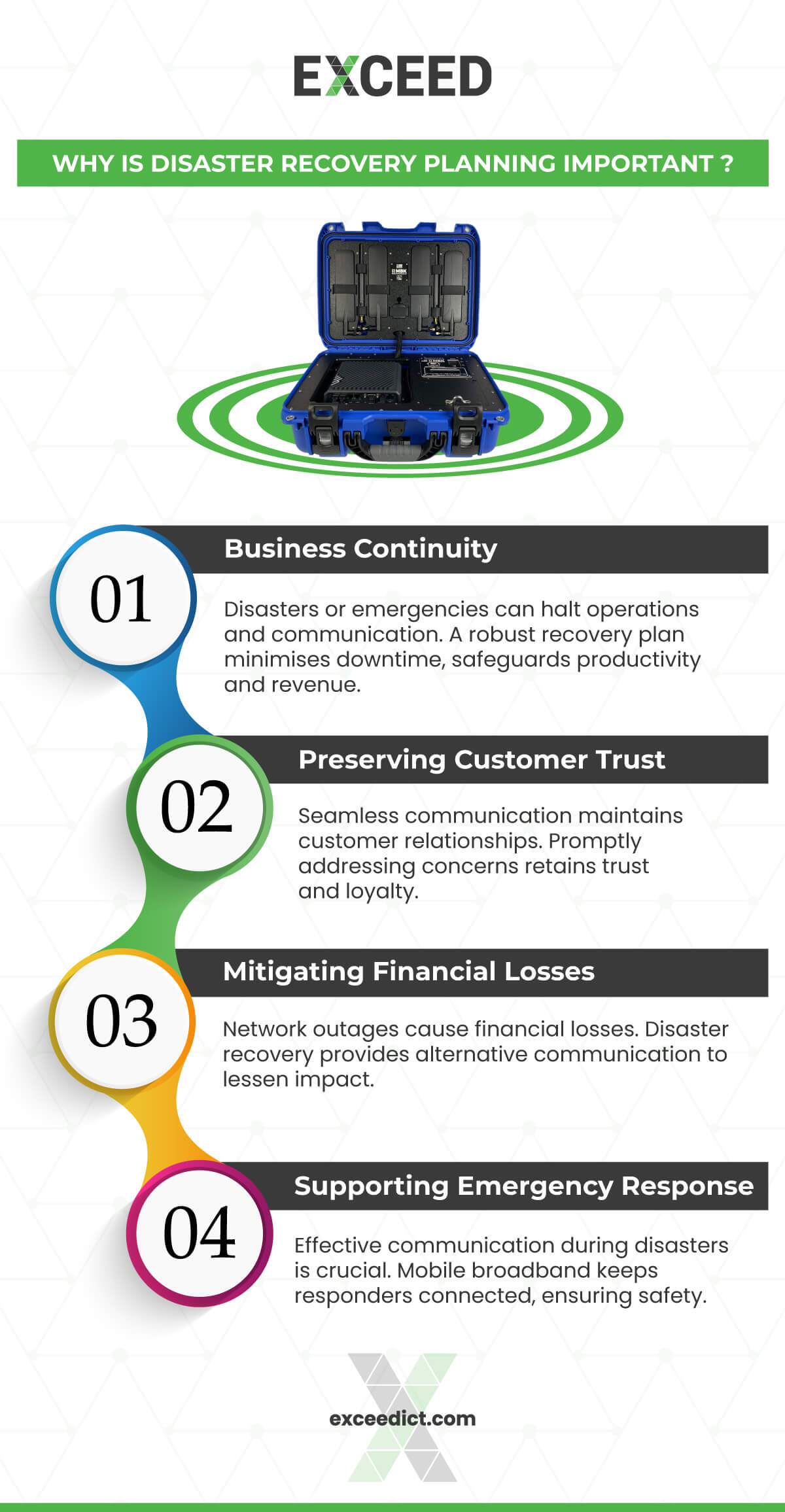
Disaster Recovery Planning: Ensuring Connectivity in Crisis
 In today’s fast-paced digital world, uninterrupted connectivity is crucial for businesses to operate efficiently. However, unforeseen disasters or emergencies can disrupt traditional means of communication, such as wired networks. That’s where disaster recovery planning comes into play.
In today’s fast-paced digital world, uninterrupted connectivity is crucial for businesses to operate efficiently. However, unforeseen disasters or emergencies can disrupt traditional means of communication, such as wired networks. That’s where disaster recovery planning comes into play.
By implementing robust strategies and solutions, organisations can ensure seamless connectivity even during times of crisis.
In this article, we will explore the significance of disaster recovery planning and provide actionable insights for businesses to protect their communication infrastructure effectively.
Disaster Recovery Planning: An Overview
What is Disaster Recovery Planning?
Disaster recovery planning refers to the process of developing and implementing strategies to maintain and restore connectivity during emergencies or disaster situations. It involves leveraging mobile broadband technologies, such as 4G and 5G networks, to establish reliable and resilient communication channels when traditional networks are unavailable or disrupted.
Why is Disaster Recovery Planning Important?
 Disaster recovery planning is essential for organisations across various industries.
Disaster recovery planning is essential for organisations across various industries.
Here are a few reasons why it holds immense significance:
>> Ensuring Business Continuity: Disasters or emergencies can halt operations and hinder communication channels. By having a robust disaster recovery plan in place, businesses can minimise downtime and continue critical operations, safeguarding their productivity and revenue streams.
>> Preserving Customer Trust: Seamless communication is vital for maintaining customer relationships. When faced with a crisis, organisations that can promptly address customer concerns and provide updates are more likely to retain customer trust and loyalty.
>> Mitigating Financial Losses: Extended network outages can result in significant financial losses due to disrupted services, missed opportunities, and delayed transactions. Disaster recovery planning helps mitigate these losses by providing alternative means of communication and connectivity.
>> Supporting Emergency Response Efforts: During natural disasters or public emergencies, effective communication is crucial for coordinating emergency response efforts. Mobile broadband disaster recovery planning enables emergency responders to stay connected, share critical information, and ensure the safety and well-being of affected individuals.
Disaster Recovery Planning: Key Considerations
Implementing an effective disaster recovery plan requires careful consideration of various factors.
Let’s explore some key considerations for organisations to ensure comprehensive preparedness:
Before developing a disaster recovery plan, businesses must conduct a thorough assessment of their vulnerabilities and risks. This involves identifying potential threats, such as natural disasters, cyberattacks, or infrastructure failures, that could disrupt their communication networks. By understanding these risks, organisations can develop targeted strategies to address them.

>> Assessing Vulnerabilities and Risks
>> Establishing Redundant Communication Channels
One of the fundamental aspects of mobile broadband disaster recovery planning is establishing redundant communication channels. This involves leveraging multiple service providers and technologies to ensure backup connectivity. By diversifying their communication infrastructure, organisations can reduce the risk of a single point of failure.
>> Deploying Mobile Broadband Routers
Mobile broadband routers play a crucial role in disaster recovery planning. These devices enable businesses to establish temporary communication networks using cellular data connections. By deploying mobile broadband routers strategically, organisations can quickly restore connectivity in crisis situations.
>> Testing and Training
An effective disaster recovery plan is only as good as its implementation. Regular testing and training are essential to ensure that employees are familiar with the plan and can execute it seamlessly. Conducting drills and simulations will help identify any gaps or areas for improvement in the plan and allow for necessary adjustments.
>> Collaborating with Service Providers
Collaboration with service providers is vital for successful disaster recovery planning. Organisations should establish strong partnerships with mobile network operators and broadband service providers. These partnerships can ensure priority access to network resources during emergencies and facilitate faster restoration of services.
>> Monitoring and Maintenance
Disaster recovery planning is an ongoing process. Regular monitoring of network performance and maintenance of equipment and infrastructure are crucial to ensure readiness. Proactive monitoring allows organisations to identify potential issues before they escalate and affect connectivity.
Types of disaster recovery planning:
- Offsite Data Backup and Recovery: Storing backups of critical data at an offsite location for restoration during a disaster.
- Cloud-Based Disaster Recovery: Replicating data and infrastructure to a cloud service provider for quick recovery.
- Cold Site Disaster Recovery: Having a basic secondary location without pre-installed equipment that can be set up and restored from backups during a disaster.
- Warm Site Disaster Recovery: Maintaining a partially equipped secondary site ready to take over operations in a disaster.
- Hot Site Disaster Recovery: Operating a fully functional secondary site mirroring the primary site for seamless transition during a disaster.
- Mobile Recovery Centers: Deploying self-contained units with temporary infrastructure to affected areas for immediate operations.
- Virtualization-Based Disaster Recovery: Replicating critical systems and data in virtual environments for rapid recovery.
- Active-Active Disaster Recovery: Running multiple active data centres simultaneously to ensure continuous operations.
- Data Replication and Mirroring: Continuously synchronising data between primary and secondary locations to minimise data loss.
- Hybrid Disaster Recovery: Combining different approaches, such as on-premises infrastructure, cloud solutions, and third-party services, for a flexible and comprehensive strategy.
Remember to consider factors like budget, recovery objectives, and system criticality when choosing the appropriate disaster recovery plan.
FAQs about Mobile Broadband Disaster Recovery Planning
 Q: What are the key components of a mobile broadband disaster recovery plan?
Q: What are the key components of a mobile broadband disaster recovery plan?
Ans: A comprehensive disaster recovery plan includes risk assessment, redundant communication channels, mobile broadband routers, testing and training, collaboration with service providers, and continuous monitoring.
Q: Can small businesses benefit from disaster recovery planning?
Ans: Absolutely! This planning is beneficial for businesses of all sizes. It helps small businesses maintain continuity during crises and safeguards their operations and customer relationships.
Q: Are mobile broadband routers easy to deploy and use?
Ans: Yes, mobile broadband routers are designed to be user-friendly and easy to deploy. They typically require minimal technical expertise and can be quickly set up to establish temporary communication networks.
Q: Can disaster recovery planning protect against cyberattacks?
Ans: While This planning focuses primarily on ensuring connectivity during crises, it can indirectly contribute to cybersecurity. By diversifying communication channels and having backup systems in place, organisations can mitigate the risk of cyberattacks.
Q: Is disaster recovery planning costly?
Ans: The cost of disaster recovery planning can vary depending on the size and requirements of the organisation. However, the cost of implementing a plan is often outweighed by the potential financial losses that can occur during network outages.
Q: Can disaster recovery planning be customised for specific industries?
Ans: Absolutely! disaster recovery planning can be tailored to the unique needs and requirements of different industries, ensuring that critical operations and services are restored promptly.
Disaster recovery planning is a critical aspect of ensuring uninterrupted connectivity and communication during crises or emergencies. By developing robust strategies, leveraging mobile broadband technologies, and collaborating with service providers, organisations can safeguard their operations, preserve customer trust, and mitigate financial losses. Remember, preparedness is key, and investing in disaster recovery planning is an investment in the resilience and continuity of your business.
You may also like to know more about
- Wireless Emergency Kit: Staying Connected When it Matters
- Safeguard Your Business with a Network Disaster Recovery Kit.
- 5G Mobile Broadband Kits to Supercharge Your Internet.
- Mobile Broadband Kit | Everything You Need to Know.
- Mobile Broadband Kits & 4k solutions 5G 4G MBK Kits.
- Mobile Broadband Kits: Stay Connected On-The-Go.
- Understanding Mobile Broadband Kits: The Complete Guide.
Stay connected with EXCEED ICT
Stay connected with EXCEED ICT by joining our social networks (given at footer). Get the latest updates, news, and tips for enterprise device deployment. Follow us on Twitter, Facebook, and LinkedIn for the best enterprise device deployment solutions.
Help us to improve our enterprise by rating us on Google Maps. Your feedback and comments are valuable to us and will be used to make our services even better.



